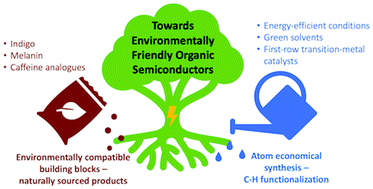Advances in applying C–H functionalization and naturally sourced building blocks in organic semiconductor synthesis
Abstract
Organic electronics is a rising field, with novel applications including but not limited to stretchable solar cells, flexible display screens, and biosensors. The high performance of these organic electronics is enabled by the outstanding optoelectronic and thermomechanical features of organic semiconducting materials. However, the production of the promising organic semiconducting materials at industrial scales has not yet become feasible, due to huge energy and capital costs in the large-scale synthesis as well as the potential damage to the environment and human health caused by vast hazardous chemical waste released. This review summarizes recent research advances in improving the environmental friendliness of the organic semiconducting material synthesis by appying atom economical C–H functionalization-based synthetic routes, minimizing hazardous chemical waste, lowering the energy consumption, and employing safe and abundant chemicals including naturally sourced semiconducting building blocks. This review showcases the remarkable progress that has been made towards the environmentally friendly organic semiconductor synthesis and provides insight for researchers developing green synthetic strategies and organic semiconductor building blocks in the future.

- This article is part of the themed collection: Organic Electronics – Ecofriendly and/or sustainable materials, processes, devices, and applications


 Please wait while we load your content...
Please wait while we load your content...